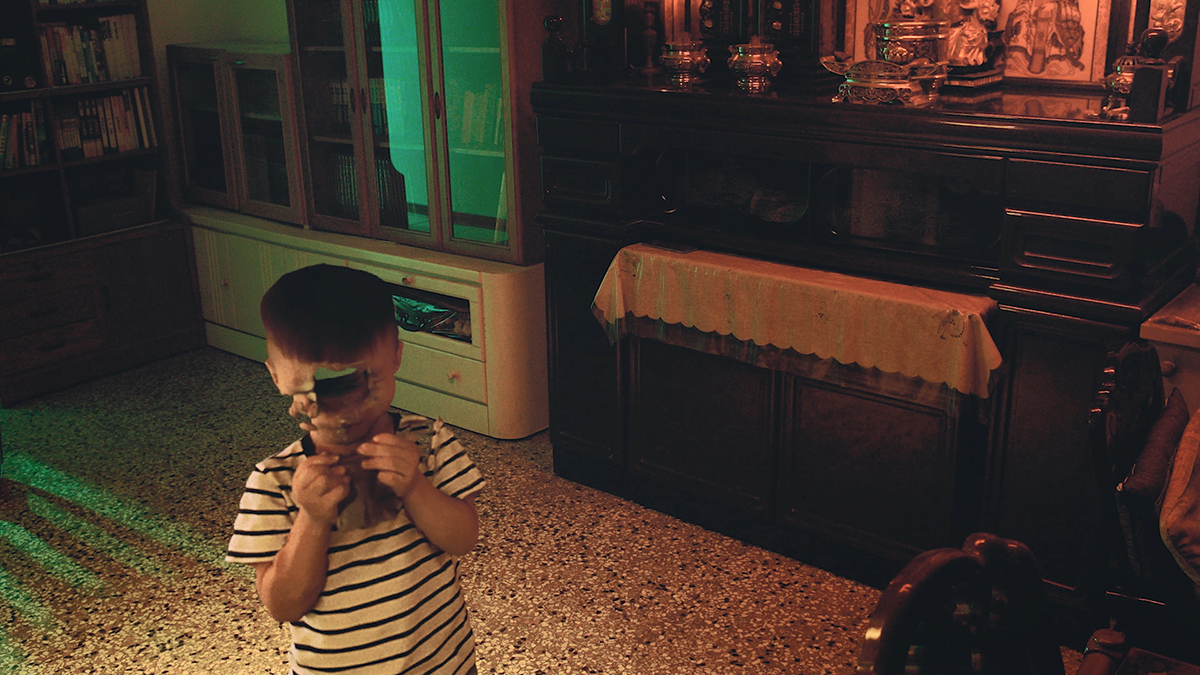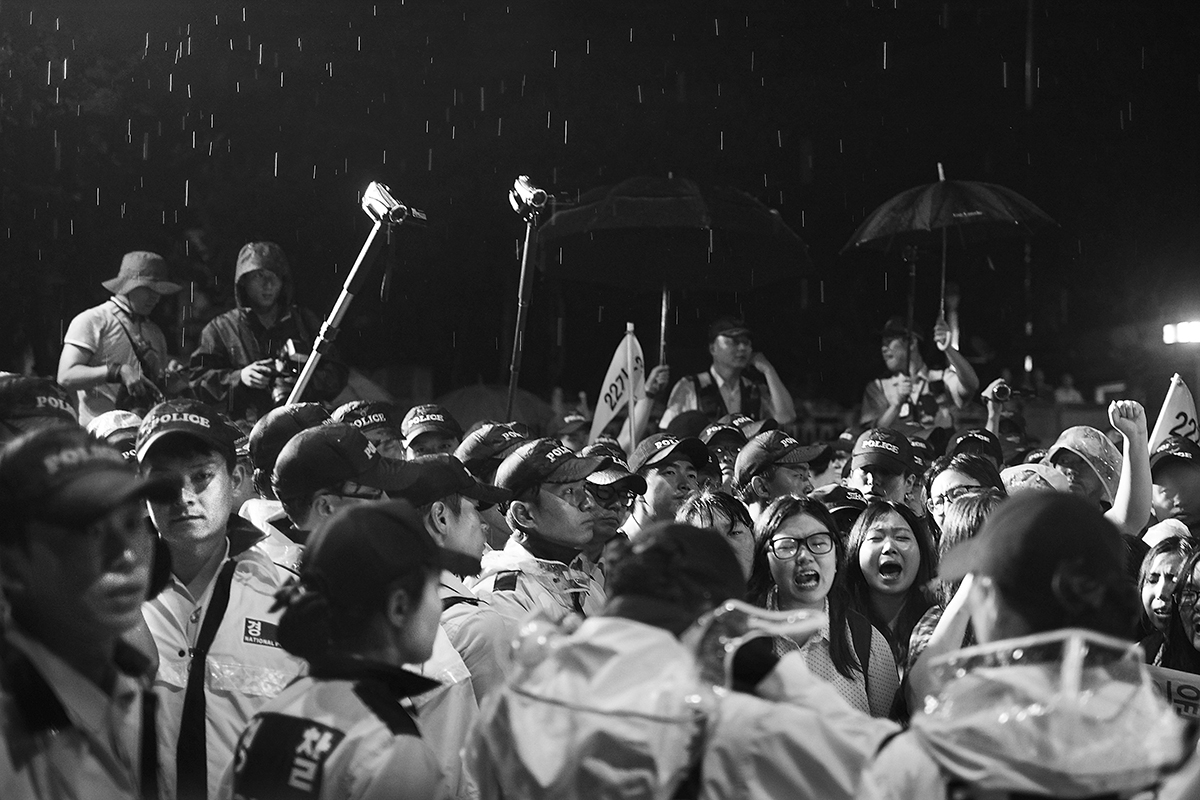This simulated getaway is frequently bitter-sweet, even melancholic, punctuated by radiant bursts of optimism and rebellion

Produced for the 11th Seoul Mediacity Biennale. Courtesy the artist.
After more than 18 months of coronavirus purgatory, we could all use a getaway. And just in time (actually, one year delayed, but never mind), the 11th Seoul Mediacity Biennale has arrived, ‘inspired by ideas of escapism’, as its introductory text says. Entering the Seoul Museum of Art, you are greeted by a gargantuan, pixelated wall painting of a mountainous landscape by Minerva Cuevas. A solitary figure is perched on a high rock above the clouds. It looks like pure bliss. On a small screen hanging before it, two actors are kissing with abandon on a beach, as the camera swirls around them – a 1995 restaging of a shot in Brian De Palma’s Body Double (1984) by Brice Dellsperger, who stars in drag, as part of his ‘Body Double’ series of film remakes.

Airy sanctuaries and passionate love: we are in paradise. Alas, reality will soon intervene. One Escape at a Time, organised by former M+ and Pompidou Centre curator Yung Ma, takes an expansive approach to its capacious theme. Spaciously installed and admirably accessible, this satisfying exhibition shows how, in difficult times, artists – and laypeople – are finding fertile means of escape in communities, the past and, perhaps most of all, art. Escapism’s dark side is here too. Ma has tapped about 40 artists to present some 50 works, which tend towards compact productions rather than grand statements – fitting for a period of confined movements and indefinite waiting. Some read like snippets of daily life. (The show’s name refers to the Netflix family sitcom One Day at a Time, 2017–20.) The mood is frequently bitter-sweet, even melancholic, punctuated by radiant bursts of optimism and rebellion.
In a trio of short videos, Li Liao films himself strolling the nearly deserted streets of Wuhan in early 2020, balancing a red plastic bag atop a long pole, amusing himself as he delivers this tidy metaphor for the precariousness of the pandemic. Bani Abidi’s The Address is from 2007 but feels of-the-moment: ten photos (one on a monitor) of spaces with a TV displaying the same empty chair and microphone. In some, people gaze at it, awaiting an announcement that will never arrive.


In an era of brutal isolation, Ma’s show convincingly argues that art – creating it, reworking it, just experiencing it – can be a means not only of escape but also of connection. It is a place where we can try to understand each other, and ourselves.
Friends have a wild night on the town in a music video by the charismatic musician Amature Amplifier (“Please keep dancing in front of me for one million years,” he sings in another), and Amy Lam and Jon McCurley’s sitcom-style Life of Life of a Craphead is a painfully accurate look at life as a young artist, balancing creative pursuits and a horrible job. Meanwhile, six Swedish art students assembled by artist Ming Wong under the name C-U-T present a K-pop-style music video, Kaleidoscope (2021), that is so lovingly produced that what might sound like parody becomes a sincere tribute to cross-cultural influence. In a behind-the-scenes interview, a C-U-T member acknowledges their influences, but explains, “We’re trying to find our own way”.

We find our way – we escape – with, and through, others. Pilvi Takala films a Helsinki startup conference in If Your Heart Wants It (remix) (2018), where would-be tech barons network and impart bromides. “Hire quickly, fire quickly,” one intones, in this portrait of personal delusions leading to collective degradation. Wang Haiyang’s Apartment (2019) is a grainy video of men meeting under cover of night at a Beijing construction site. Two embrace. In brief voice-overs (altered to cloak identities) men talk about mundanities, desire, sex. It is screened awkwardly, in a cramped storage room beneath a staircase, which lends intimacy to its viewing but also uncomfortably mirrors the marginalisation of the work’s subjects: shunted out of sight again.

There are forays into fantasy, but towards political ends, not self-indulgence. The duo Young-Hae Chang Heavy Industries offers a seven-episode video series that tells a story, with rapid-fire text, of a Samsung salaryman who dies at his desk (“like dying for your country”) and is then reincarnated as a Samsung smartphone, a napkin and more. It is an uproarious, discombobulating indictment of intense, hierarchical work cultures. Hansol Ryu’s ten-minute showstopper of a low-budget horror film, Virgin Road (2021), has a bride in a white dress rip open her head, tear apart her innards and smash her organs (along with fixed notions of gender and any sign of civilisation) underneath her high heels. It is revolting, cleansing mayhem.
The exhibition astutely foregrounds how images come into being and circulate today: in alluring fragments, as potent memes and on countless screens. De Palma sparks Dellsperger. A viral video of three Black Americans debating looting becomes the heart of I Understand… (2021), a raw video essay about the limits of empathy by Hao Jingban. Alongside footage of a Catholic reliquary procession, Justin Bieber turns into a godlike presence in a concert excerpted in Paul Pfeiffer’s Incarnator (2018–21); thousands raise their phones to snap photos for their followers.

The biennale has mirrored this mass distribution by including tiny bits of the show at about 100 Seoul cafés and shops: a poster of the C-U-T crew in an ice-cream store, an Oliver Laric video next to bespoke cakes. An enormous screen at the coex Artium devoted to luxury ads hosts occasional screenings. (I enjoyed Bieber hawking Balenciaga while awaiting a sly, seductive piece by the curatorial outfit Tastehouse and the graphic-design outfit Works.) In a bracing visualisation of the current digital panopticon, Yes We Cam (2012–16), Kim Min arrays on a wall snapshots of South Korean police recording protests and documents from his indictment after attending a demonstration.

Much of the time our escapes are fleeting or illusory – a level of distraction achieved by scrolling infinite feeds, buffeted by advertising and notifications, on networks optimised for pleasure, commerce and surveillance. And so the most indelible piece in Mediacity, for me, depicts that whole regime melting away. In Kang Sang-woo’s lush video Forest Neighbor (2021), lightning hits a powerline in a rural area, and the lights go out in a nearby home. A young man tries to remedy the situation as his sister ventures into the surrounding forest. Amid its shadows, she happens upon a film shoot. “We are almost done,” a worker tells her. Suddenly its bright lights cut, and her phone illuminates her path. A snake slithers by her, but she has her eye on something else: a mushroom. She crouches down and picks it.
From the October 2021 issue of ArtReview